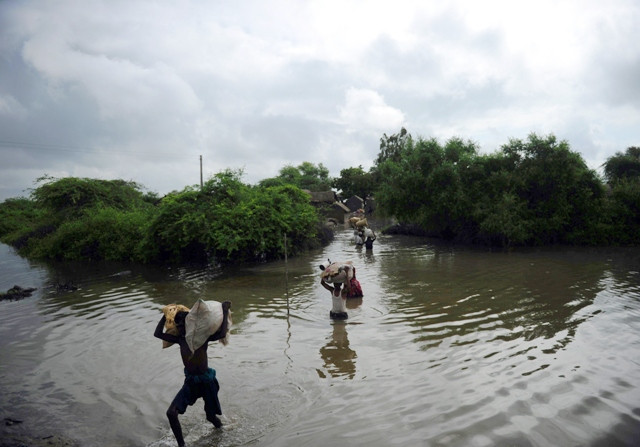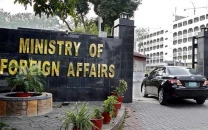Monsoonal meandering: Are we prepared this time around?
With forecasts of heavy rainfall, the time has come for disaster management authorities to spring into action.

With forecasts of heavy rainfall this season, the time has come for disaster management authorities to spring into action. PHOTO: AFP/FILE
Like clockwork, the monsoon season is upon us once again. And yet, it seems that history is about to repeat itself. Although the first spell has only just begun, critical dams find themselves already near capacity level, rainfall levels are expected to keep rising, and predictions for flash flooding in various parts of the country are ripe.
A slushy summer, a flooded fall
According to the Pakistan Meteorological Department (PMD), back-to-back monsoon spells in the upcoming months – below average rainfall in July and average in August – will be followed by above average rainfall in September. Accompanying the erratic spread of monsoon will be serious flooding.
PMD officials have predicted excessive snow melt due to soaring temperatures. Although this will cause floods in all four provinces, some areas will be far more affected than others.
“Rainfall activity will mainly be concentrated in the central and southern parts of the country,” said Chief Meteorologist.
More worrisome is the fact that although the monsoon season has started with below average rainfall, the reservoirs at Tarbela and Mangla dams are already very close to reaching their maximum capacity.

What about the NDMA?
Despite the worrisome forecasts, the eight-year-old National Disaster Management Authority (NDMA) finds itself seemingly unprepared, as very little has been done on ground.
Addressing this, NDMA officials blamed the meagre funds as the reason why practical steps are not being taken to prepare for the floods. The government has allotted Rs180 million for 2013-14 while, last year, on demand of NDMA, the government released an amount of Rs5 billion.
And yet, according to Idrees Mehsud, a member of NDMA’s Disaster Risk Eradication, meetings have been held with the provincial disaster management authorities to chalk out a strategy.
According to the documents available with The Express Tribune, the National Disaster Management has formulated a prospective ten years National Disaster Management Plan to manage a range of disasters.

The overall plan has a total investment cost of $1040.9 million over a period of ten-year. The authority, however, is still waiting for the approval of funds from the government.
Speaking to The Express Tribune, an official from the national authority said that the government has been holding regular meetings, trying to finalise the contingency plan.
He revealed the plan is expected to be launched next week.
Provincial efforts under way
On a provincial level, it appears that the dreary forecasts are not falling on deaf ears. According to the Provincial Disaster Management Authority (PDMA), measures have already been taken to prepare for the consequences.
Latifur Rehman, the media officer of PDMA K-P, said the provincial government, under the monsoon contingency plan, has already arranged for basic necessities, including medicines for all districts. PDMA Peshawar has provided 104 boats to the Pakistan army, and 50,000 camps and blankets have been sent to district coordination officers. According to Rehman, the Kabul and Swat rivers are regularly being monitored. Peshawar, Charsadda, Mardan, Swat, Shangla, Dir Upper and Dir Lower, Tank and DI Khan have been identified as potentially vulnerable areas.
In this vein, PDMA Balochistan Director General Khalid Baloch said they are well prepared for a weather emergency. The body is in constant contact with the NDMA, and two meetings have been convened to finalise the measures. Baloch pointed towards Jaffarabad, Jhal Magsi, Sibi, Harnai, Zhob and Naseerabad as regions at risk.
Punjab, too, seems to be making emergency plans. According to officials, just last month, Chief Secretary Javed Aslam
decided on the storage of baskets, food and bags of sands
at the banks of rivers and canals for use in case of possible floods.
Similarly, PDMA Sindh Director General Salman Shah convened a meeting on Tuesday to prepare for the monsoon rains.
Humanitarian experts who met in Islamabad on Monday recommended that at least 2% of the development budget should be allocated to programmes that reduce the risk of disasters and strengthen disaster management authorities at the provincial and the district level.
According to Oxfam, a UK-based humanitarian group, current development projects and structures have contributed to disasters, so it is very important to cater to projects that thwart mishaps.
Experts also believed that officials should be given permanent positions with adequate resources and a legal authority to coordinate district disaster plans.
Published in The Express Tribune, July 9th, 2013.





1675249047-0/image-(18)1675249047-0-208x130.webp)













COMMENTS
Comments are moderated and generally will be posted if they are on-topic and not abusive.
For more information, please see our Comments FAQ